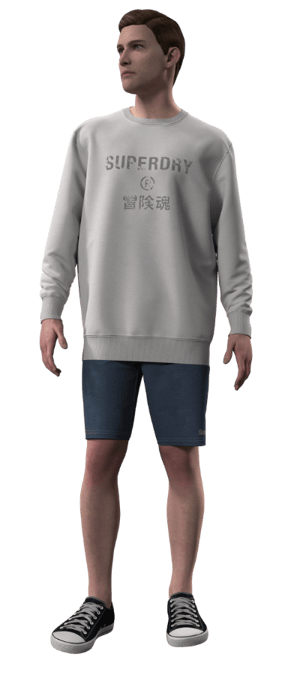Perry Ellis Goes Smart-to-Market: 50% Sample Reduction, 100% Fit Confidence
Discover how Perry Ellis uses Browzwear’s 3D technology to enhance design efficiency, cut costs, and innovate with a smart-to-market approach.
May 12, 2021

Superdry is a leading UK contemporary clothing brand, delivering both timeless and on-trend high-quality products for men and women that combine Americana style with Japanese-inspired graphics. Since its founding in 2003, Superdy’s global presence continues to grow, operating across 768 branded locations in 65 countries. All of Superdry’s garments are defined by their authentic vintage washes, distinctive detailing, and tailored fits. As a brand, Superdry has remained committed to creating a positive environmental legacy, setting itself a goal to become the most sustainable listed global fashion brand on the planet by 2030.
 The Need for 3D
The Need for 3DFor Superdry, the fusion between market-leading quality and design detail is core to the brand DNA. There, the company is constantly striving to uphold its customer loyalty whilst expanding its territories. In recent years, Superdry began to rethink its sizing strategy as a way to be able to cater to a wider audience per region, explore different fit profiles, and avoid sizing inconsistencies. The design team started to categorize customers based on lifestyle and age in order to establish a wider variety of customer profiles, for example, oversize for younger wearers in contrast to a slim fit for an older shopper. It was at this point that the company began to dive into the possibilities of incorporating digital solutions as a way to put its plans into action, and in 2018 teamed up with Browzwear to begin its 3D design journey.
As Superdry embarked on its digital path, its initial priority was to diversify the brand’s body sizing and grade rules to ensure that all of its products were in tune with all of its shoppers’ bodies. To launch its sizing strategy, the company also collaborated with WAIR, a leading body data and sizing intelligence solution that seamlessly integrates with Browzwear’s 3D fashion design software, VStitcher. “Our initial goal when implementing digital tools into our workflow was for us to have the ability factor in different types of fits within the same body sizing,” says Deborah Painting , Head of Quality & Technical at Superdry. “After analyzing our sizing according to gender, weight, height, and body dimensions with WAIR’s algorithm, we came out with a 3D avatar that could be imported directly into VStitcher and adapted accordingly to the different sizes. It was not long before we realized the possibilities presented by 3D when it came to fit and sizing,” she adds.
To accelerate its sizing efforts the graphic design team began to use 3D assets in their workflow, starting off by focusing on artwork placement and color-ups of graphics and logos. Meanwhile, the Tech Team was concentrating on the creation of a core block library within VStitcher. This included t-shirts, hoodies, crewnecks, joggers, and polos for both men and women as well as fit line-ups such as classic, standard, loose, box, and oversize. “Within a short amount of time, we started to create fantastic true-to-life 3D assets that we use to present styles internally, to visually communicate what the options are for each design,” says Deborah.
“As opposed to working on flat drawings, when we load up our parametric avatar in VStitcher and dress it in our core blocks, we are immediately able to see what works and what doesn’t and use features such as tension maps to analyze exactly how the garment fits in proportion to a real human body. Then we can make the necessary changes instantly, revisualize it, and ultimately get the styles approved quicker,” she adds. “As the wider design team begins to work in 3D, the first stage of our journey will be realized: a faster turnaround time and a more efficient way of working as we no longer require numerous physical samples to assess and approve each garment.”

Although the company is still in the early stages of its digital transformation journey, 3D is certainly on the roadmap for 2021. “Over the past year, we have really started to change the way we work internally to really embrace 3D and push it as far as we can. Our next step is to tackle more complex styles such as outerwear, denim, and woven garments as well further customize our avatars to fit our customer profiles,” says Deborah. With Browzwear’s e-learning platform, Browzwear University, the company also has plans to skill up more employees and introduce 3D to the design team so that they can effectively engage with suppliers who already work with the software. “It was apparent from the start that 3D is a much more efficient and effective way of working, and now that we have started to build the foundations for 3D implementation we are excited to embark on our next steps,” says Deborah.

Styles can be created, amended, and approved quicker

The ability to visualize and adapt artwork across sizes

Assess the fit in proportion to a real human

Reduce the number of physical samples
“Within a short amount of time, we started to create fantastic true-to-life 3D assets that we use to present styles internally, to visually communicate what the options are for each design,”

Discover how Perry Ellis uses Browzwear’s 3D technology to enhance design efficiency, cut costs, and innovate with a smart-to-market approach.
Tendam leverages Browzwear's 3D tech to boost speed-to-market, enhance creativity, and reduce waste across its fashion brands.
Discover how Oasis, a leading Vietnam-based manufacturer, uses Browzwear to streamline workflows, cut costs, and deliver high-quality jackets with...